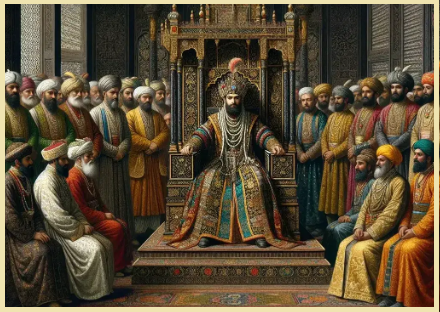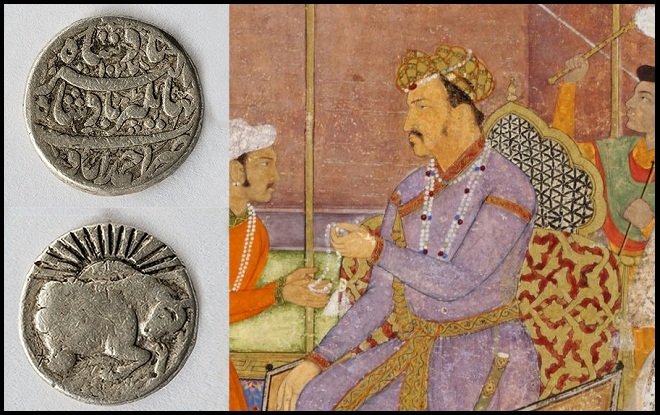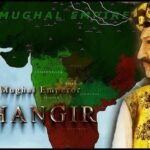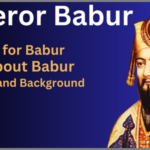Akbar’s Remarkable Reign
Akbar the Great ruled from 1556 to 1605, and during that time, he didn’t just solidify the Mughal Empire’s power—he reshaped its entire foundation.
Akbar the Great ruled from 1556 to 1605, and during this time, he didn’t just expand the Mughal Empire’s reach—he reshaped it entirely. His reign is remembered for how it revolutionized the empire’s political, cultural, and military systems. Akbar wasn’t just a fierce warrior; he was also a visionary leader who understood the value of reform and innovation in governance. The legacy he left behind isn’t just marked by the lands he conquered, but by the profound changes he brought to India’s history.

Early Life and Ancestry
Born on October 15, 1542, Akbar’s full name was Jalal-ud-din Muhammad Akbar. Along with his father, Emperor Humayun, and grandfather, Babur; he was a member of the Timurid dynasty, which laid the groundwork for the Mughal Empire in India. The legendary emperors Genghis Khan and Timur were the ancestors of his mixed Mongol and Turkish blood. Growing up in a time of upheaval, Akbar’s early years were spent traveling and witnessing his father’s fortunes change, which profoundly affected his views on power and governance.
Military Campaigns and Innovations
From the moment Akbar ascended the throne at the age of 13, he was thrust into military challenges. Under the guidance of his regent, Bairam Khan, Akbar won the decisive Second Battle of Panipat in 1556, securing his position. Akbar’s dominion grew over time to include North and Central India, Rajputana, Western and Eastern India, and even the difficult territories of Afghanistan and Baluchistan. His military campaigns were based on cautious diplomacy, alliance building, and integrating overthrown monarchs into his administration rather than only using force.
One of Akbar’s key military innovations was the Mansabdari system, which helped him organize and maintain a professional standing army. By assigning ranks and ensuring a direct relationship between the emperor and his soldiers, Akbar could rely on a loyal and efficient military force. His campaigns extended as far as Kandahar, where his rivalry with the Safavids played out, and to the Deccan Sultans, where he skillfully expanded Mughal influence.

Administration, Political Structure, and Taxation
Akbar’s political genius lay in his administrative reforms. Administration, Political Structure, and Taxation
Akbar’s political genius lay in his administrative reforms. He reorganized the empire’s political structure, creating a centralized government where he was the ultimate authority but delegated power through a system of subahs (provinces). His revenue system, known as the Zabt system, standardized taxation based on land productivity, ensuring fairness while maximizing the state’s income.
Akbar’s administration was inclusive.
Akbar wasn’t the kind of ruler who gave important positions only to Muslims. He made sure to involve people from various communities like Hindus, Jains, and others, recognizing their talents and contributions. This open-minded approach helped him win the trust and loyalty of people from all walks of life, regardless of their religion. It was a true reflection of his inclusive way of thinking and ruling.
This approach was in line with his well-known philosophy, Din-i Ilahi, which aimed to go beyond religious divisions and bring everyone in the empire together under a shared spiritual vision.
Akbar’s Capitals and Cultural Contributions
Though Akbar initially ruled from Agra, he founded a new capital at Fatehpur Sikri in 1571, which became the center of cultural and intellectual exchange.
Although the city was eventually abandoned because of water shortages, it still serves as a powerful reminder of Akbar’s dream for a perfect Mughals capital. The buildings there beautifully blend Persian, Indian, and Islamic architectural styles, reflecting Akbar’s inclusive and harmonious way of ruling. His vision brought together different cultures, much like his approach to governing his empire
In terms of culture, Akbar was a great patron of the arts.
Intellectuals, poets, artists, and musicians from all over the world were drawn to the Mughal court, which was a bustling hub of creativity.
The famous Akbarnāma, written by his court historian Abu’l-Fazl, details his reign and reflects his deep interest in documenting history and governance.
Relations with Foreign Powers: Portuguese, Ottomans, and Safavids
Akbar’s foreign relations were equally fascinating. His relations with the Portuguese were primarily focused on securing trade routes, particularly for spices. Despite occasional conflicts, Akbar maintained a pragmatic approach, recognizing the benefits of commerce. He was more subtle in his diplomacy with the Ottoman Empire and the Safavid dynasty, navigating the Islamic world’s geopolitics and frequently used the rivalry between the two nations to his advantage.

Religious Policy: Akbar and the Din-i Ilahi
Akbar’s religious policy was revolutionary for its time.
Akbar believed deeply in creating peace and understanding among the many religious communities in India. His most well-known initiative,Din-i Ilahi, was an effort to blend the best aspects of different faiths like Hinduism, Islam, Jainism, and Zoroastrianism into one spiritual philosophy. While it didn’t gain widespread popularity, Din-i Ilahi represented Akbar’s forward-thinking views on religion and his strong desire to bring unity to his diverse empire.
When it came to diplomacy, Akbar was a true strategist.
His matrimonial alliances—marrying into different royal families—were a clever way to build political ties and strengthen his empire. These marriages played a significant role in keeping the peace and forming alliances with various kingdoms.
He married Rajput princesses, which not only secured the loyalty of powerful Rajput clans but also helped to integrate them into the Mughal administrative and military structures. These alliances were critical in maintaining peace in Rajputana and allowed Akbar to focus on other parts of his empire.

Economic Prosperity, Trade, and Coins
The Mughal Empire under Akbar experienced significant economic prosperity. Trade flourished, especially with the expansion of the empire into fertile and resource-rich regions. Akbar’s introduction of a standardized currency system, includingsilver coins known as rupiyas, helped stabilize the economy and facilitated trade both within the empire and with foreign nations.
Akbar’s Personality and Legacy
Akbar’s personalityhas was the subject of much admiration and myth-making. Contemporary historians and later chroniclers have often highlighted his physical courage, strategic acumen, and progressive mindset. His hagiography presents him as a near-divine figure, which is echoed in the detailed Akbarnāma, a three-volume account of his reign.
Akbar was renowned for his sincere concern for his people’s welfare despite his extravagant appearance. His religious tolerance, administrative reforms, and emphasis on justice earned him a reputation as a benevolent and wise ruler.
Assassination Attempts and Challenges
Akbar’s long reign was not without threats. He survived at least one assassination attempt, a reminder of the internal and external challenges that any powerful ruler faced during that period. He maintained tight control in spite of these threats, outwitting his adversaries and establishing dominance over huge swaths of territory.
Death and Legacy: Akbar’s Sons and Daughters
Akbar died in 1605, leaving behind a vast empire that his successors would inherit. His sons, particularly Jahangir, continued his policies but with varying degrees of success. His daughters, though less prominent in historical accounts, played important roles in the Mughal court.
Akbar had several wives, but the most famous among them are:
Mariam-uz-Zamani
(Also known as Jodha Bai) – She was a Rajput princess, the daughter of Raja Bharmal of Amer, and the mother of Akbar’s successor, Jahangir.
Ruqaiya Sultan Begum
She was Akbar’s first wife and chief consort. She was also his cousin, being the granddaughter of Babur, the founder of the Mughal dynasty.
Salima Sultan Begum
She was Akbar’s third wife and the widow of his regent, Bairam Khan. Salima was known for her intelligence and influence at court.
Mariam-uz-Zamani, often referred to in popular culture as Jodha Bai, is one of the most well-known figures due to her significance in Akbar’s life and her role as the mother of his heir.
The sons of Mughal Emperor Akbar were:
Jahangir
(Born as Salim) – He succeeded Akbar as the fourth Mughal emperor and ruled from 1605 to 1627.
Murad
He was Akbar’s second son and held military responsibilities but died at a young age.
Daniyal
Akbar’s youngest son, known for his military service, but like Murad, he died young due to alcohol-related issues.
Akbar daughter
Aram Banu Begum.
Emperor Akbar is believed to have had only one biological daughter, Aram Banu Begum. While Akbar had several wives and many children, Aram Banu was his only daughter recorded in history. Some historical sources suggest he may have had other daughters, but Aram Banu is the most well-documented.

Akbar in Popular Culture: Films, Television, and Beyond
Akbar’s life and reign have been immortalized in films, television, and even video games, where he is often depicted as the epitome of a just and noble ruler. From Bollywood blockbusters like Jodhaa Akbar to television serials, Akbar continues to be a symbol of India’s rich history.
Akbar the Great wasn’t just a ruler or a conqueror; he was a visionary who truly transformed what it meant to lead an empire. What made him different from other kings of his time was not just his military innovations but also his bold administrative reforms and his deep respect for all religions. His influence on the history and culture of the Indian subcontinent runs deep, and when we look at his legacy, it’s clear that his impact has shaped the region in lasting ways. Akbar’s contributions continue to be felt even today, leaving a mark that has stood the test of time.










